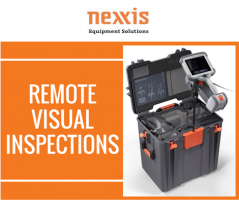Top 5 FAQs About RVI Equipment Rental

The economic climate continues to be difficult with bottom-line pressure and decelerating growth among the ongoing challenges for the majority of organisations across the spectrum of industry.
Equipment rental is one strategy that enables organisations to spend less but achieve more – and especially in the field of remote visual inspection (RVI) where technology is advancing rapidly, renting is a cost-effective way of accessing the latest innovations without having to make long-term decisions and significant capital investment.
However, despite all the advantages, there’s still a lack of understanding of the benefits of RVI equipment rental – so the following FAQs may help dispel some myths and provide some answers.
1. WHAT ARE THE BENEFITS OF RVI EQUIPMENT RENTAL?
- Leasing relieves cash-flow and budget pressure by moving the cost from a capital expense to an operating expense
- Leasing provides tax and cash-flow benefits
- Leasing allows companies to try the equipment to see if it meets individual business needs
- Leasing provides immediate and flexible solutions for peak periods, unexpected projects or when existing equipment fails
- Leasing provides opportunities to try the latest technology without any capital investment
- Leasing makes sure the right equipment is chosen for the job – no compromises
- Leasing means technical support is always available
- Leasing can minimise downtime of important processes
2. ARE THERE DIFFERENT RENTAL OPTIONS AVAILABLE?
There are numerous options available for both short and long-term rentals.
Short-term rental enables immediate access to equipment to meet temporary needs such as peak periods, when your own equipment breaks down unexpectedly or is being repaired or when an unexpected evaluation comes up. And if your project is in a remote location, remember that renting equipment is cheaper than transporting your own equipment across large distances.
Long-term RVI equipment rentals can also convert fixed costs into variable ones, freeing up capital and enabling a more favourable debt to equity ratio.
Rent-to-own is another cost-effective way of trying out the newest RVI equipment without committing capital cost upfront. Simply try the equipment out for 12 months to evaluate whether it meets your needs, then buy it at a reduced cost or upgrade to the latest equipment
3. WHAT IF I CHOOSE THE WRONG RVI EQUIPMENT FOR RENT?
Making the wrong rental choices can be avoided by partnering with a reputable supplier with a proven track record in equipment rental. They will have all the experience and expertise to assess your unique needs and they will recommend the right equipment for the job.
4. WHAT KIND OF TECHNICAL SUPPORT DO I GET WHEN I RENT RVI EQUIPMENT?
If you partner with an expert in the remote visual inspection field, you can be assured that they will provide the appropriate levels of service and support. They will be a phone call away and should be able to provide an immediate solution with minimal disruption. Essentially, renting means you get all the advantages of having state-of-the-art equipment without the hassle of maintaining it.
5. CAN I RENT THE LATEST EQUIPMENT?
Contrary to popular opinion, renting can actually provide opportunities to access the very latest in RVI equipment and to keep abreast of changing technologies. There’s nothing ‘second-best’ about renting – and those who choose RVI equipment rental know that they reap all the benefits of the latest inspection products and systems without the restrictions of ownership.
The key thing about renting RVI equipment is to always partner with a reliable, reputable supplier like Nexxis, which has a proven track record in meeting customers’ inspection needs with flexible and cost-effective equipment leasing options. Visit their website, nexxis.com to see their extensive range of RVI equipment for rent or phone them on 08 9418 4952 to speak to an expert about how your bottom-line can benefit from this flexible, cost-effective financing solution.
